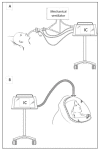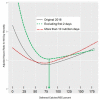Indirect Calorimetry in Clinical Practice
- PMID: 31491883
- PMCID: PMC6780066
- DOI: 10.3390/jcm8091387
Indirect Calorimetry in Clinical Practice
Abstract
Indirect calorimetry (IC) is considered as the gold standard to determine energy expenditure, by measuring pulmonary gas exchanges. It is a non-invasive technique that allows clinicians to personalize the prescription of nutrition support to the metabolic needs and promote a better clinical outcome. Recent technical developments allow accurate and easy IC measurements in spontaneously breathing patients as well as in those on mechanical ventilation. The implementation of IC in clinical routine should be promoted in order to optimize the cost-benefit balance of nutrition therapy. This review aims at summarizing the latest innovations of IC as well as the clinical indications, benefits, and limitations.
Keywords: indirect calorimeter; indirect calorimetry; nutrition therapy; resting energy expenditure.
Conflict of interest statement
CP received financial support as an unrestricted academic research grant from public institutions (Geneva University Hospital) and the Foundation Nutrition 2000 Plus. CP received financial support as research grants and an unrestricted academic research grant, as well as an unrestricted research grant and consulting fees, from Abbott, Baxter, B. Braun, Cosmed, Fresenius-Kabi, Nestle Medical Nutrition, Novartis, Nutricia-Numico, Pfizer, and Solvay, outside the submitted work. M.M.B. received research grants and public academic research grants, unrestricted research grand from Fresenius Kabi International, consulting fees from Fresenius Kabi International, and honoraria for lectures for Fresenius Kabi, Nestle. The other authors declare that they have no conflict of interest related to the current work. The funders had no role in the design of the study; in the collection, analyses, or interpretation of data; in the writing of the manuscript, or in the decision to publish the results.
Figures






Similar articles
-
Indirect calorimetry in nutritional therapy. A position paper by the ICALIC study group.Clin Nutr. 2017 Jun;36(3):651-662. doi: 10.1016/j.clnu.2016.06.010. Epub 2016 Jun 22. Clin Nutr. 2017. PMID: 27373497 Review.
-
Indirect calorimetry: The 6 main issues.Clin Nutr. 2021 Jan;40(1):4-14. doi: 10.1016/j.clnu.2020.06.024. Epub 2020 Jul 2. Clin Nutr. 2021. PMID: 32709554 Review.
-
Innovations in energy expenditure assessment.Curr Opin Clin Nutr Metab Care. 2018 Sep;21(5):321-328. doi: 10.1097/MCO.0000000000000489. Curr Opin Clin Nutr Metab Care. 2018. PMID: 29912811 Review.
-
Preventing Underfeeding and Overfeeding: A Clinician's Guide to the Acquisition and Implementation of Indirect Calorimetry.Nutr Clin Pract. 2018 Apr;33(2):198-205. doi: 10.1177/0884533617710214. Epub 2017 Dec 14. Nutr Clin Pract. 2018. PMID: 28549221
-
Do PICU patients meet technical criteria for performing indirect calorimetry?Clin Nutr ESPEN. 2016 Oct;15:80-84. doi: 10.1016/j.clnesp.2016.06.003. Epub 2016 Jun 28. Clin Nutr ESPEN. 2016. PMID: 28531789
Cited by
-
New, Optimized Skin Calorimeter Version for Measuring Thermal Responses of Localized Skin Areas during Physical Activity.Sensors (Basel). 2024 Sep 12;24(18):5927. doi: 10.3390/s24185927. Sensors (Basel). 2024. PMID: 39338672 Free PMC article.
-
Longitudinal analysis of resting energy expenditure and body mass composition in physically active children and adolescents.BMC Pediatr. 2022 May 10;22(1):260. doi: 10.1186/s12887-022-03326-x. BMC Pediatr. 2022. PMID: 35538456 Free PMC article.
-
Gut dysmotility in children with neurological impairment: the nutritional management.Front Neurol. 2023 May 5;14:1200101. doi: 10.3389/fneur.2023.1200101. eCollection 2023. Front Neurol. 2023. PMID: 37213895 Free PMC article. Review.
-
Resting energy expenditure in patients with liver cirrhosis: Indirect calorimetry vs. predictive equations.Asia Pac J Clin Nutr. 2024 Dec;33(4):545-553. doi: 10.6133/apjcn.202412_33(4).0009. Asia Pac J Clin Nutr. 2024. PMID: 39209364 Free PMC article.
-
[A brief discussion on precision nutrition support for severe burn patients from theory to practice].Zhonghua Shao Shang Yu Chuang Mian Xiu Fu Za Zhi. 2022 Aug 20;38(8):701-706. doi: 10.3760/cma.j.cn501225-20220517-00189. Zhonghua Shao Shang Yu Chuang Mian Xiu Fu Za Zhi. 2022. PMID: 36058692 Free PMC article. Chinese.
References
-
- Singer P., Anbar R., Cohen J., Shapiro H., Shalita-Chesner M., Lev S., Grozovski E., Theilla M., Frishman S., Madar Z. The tight calorie control study (TICACOS), a prospective, randomized, controlled pilot study of nutritional support in critically ill patients. Intensiv. Care Med. 2011;37:601–609. doi: 10.1007/s00134-011-2146-z. - DOI - PubMed
-
- Heidegger C.P., Berger M.M., Graf S., Zingg W., Darmon P., Costanza M.C., Thibault R., Pichard C. Optimisation of energy provision with supplemental parenteral nutrition in critically ill patients: A randomised controlled clinical trial. Lancet. 2013;381:385–393. doi: 10.1016/S0140-6736(12)61351-8. - DOI - PubMed
Publication types
LinkOut - more resources
Full Text Sources
Medical

